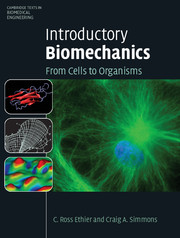Book contents
- Frontmatter
- Contents
- About the cover
- Preface
- 1 Introduction
- 2 Cellular biomechanics
- 3 Hemodynamics
- 4 The circulatory system
- 5 The interstitium
- 6 Ocular biomechanics
- 7 The respiratory system
- 8 Muscles and movement
- 9 Skeletal biomechanics
- 10 Terrestrial locomotion
- Appendix: The electrocardiogram
- Index
- Plate section
- References
6 - Ocular biomechanics
Published online by Cambridge University Press: 05 June 2012
- Frontmatter
- Contents
- About the cover
- Preface
- 1 Introduction
- 2 Cellular biomechanics
- 3 Hemodynamics
- 4 The circulatory system
- 5 The interstitium
- 6 Ocular biomechanics
- 7 The respiratory system
- 8 Muscles and movement
- 9 Skeletal biomechanics
- 10 Terrestrial locomotion
- Appendix: The electrocardiogram
- Index
- Plate section
- References
Summary
At first, it may seem like biomechanics play little or no role in the eye, but nothing could be further from the truth. In fact, the eye is a pressurized, thick-walled shell with dedicated fluid production and drainage tissues, whose shape is controlled by biomechanical factors. It has internal and external musculature, a remarkably complex internal vascular system, and a variety of specialized fluid and solute transport systems. Biomechanics play a central role in accommodation (focussing near and far), as well as in common disorders such as glaucoma, macular degeneration, myopia (near-sightedness), and presbyopia (inability to focus on nearby objects). To appreciate the role of biomechanics in these processes we must first briefly review ocular anatomy.
Ocular anatomy
The eye is a remarkable organ. It functions like a camera, with an adjustable compound lens, an adjustable aperture (the pupil), and a light-sensitive medium (the retina) that converts photons into electrochemical signals (Fig. 6.1, color plate). The eye automatically adjusts pupil size and lens shape so that images are clear under a wide variety of lighting conditions and over a wide range of distances from the observer.
The outer coat of the eye is formed by the cornea and sclera, two tough connective tissues that together make up the corneoscleral shell. This shell is pierced at the back of the eye by the scleral canal and at other discrete locations by small vessels and nerves.
- Type
- Chapter
- Information
- Introductory BiomechanicsFrom Cells to Organisms, pp. 250 - 281Publisher: Cambridge University PressPrint publication year: 2007



